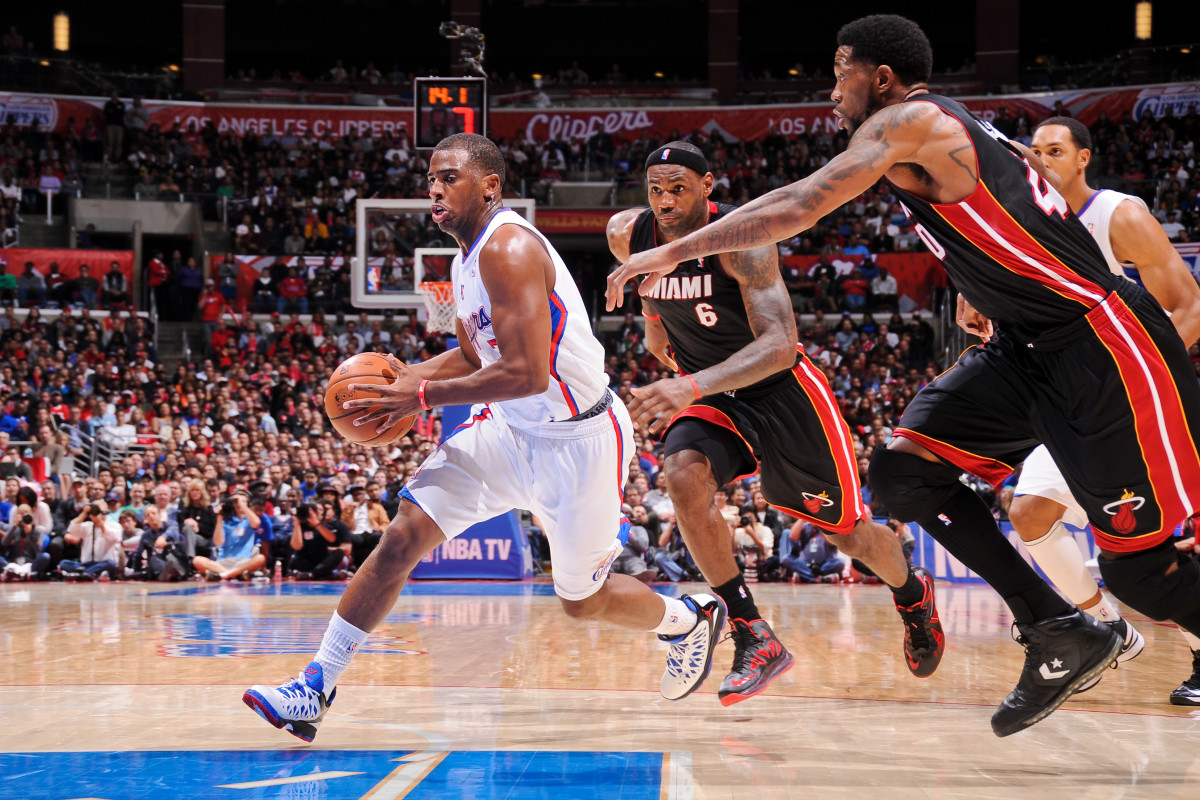Three-pointers: Clippers capitalize on Heat's sinking defense

Chris Paul and the Clippers were able to consistently infiltrate the Heat defense. (Photo by Noah Graham/Getty Images)

By Rob Mahoney
After jostling with the Miami Heat for 35 minutes, the Los Angeles Clippers created separation down the stretch to win in a walk 107-100 on Wednesday in Los Angeles. Chris Paul closed the third quarter with 13 consecutive Clippers points and Eric Bledsoe opened the fourth with the team's first eight points as L.A. pulled away for its fourth consecutive victory despite LeBron James' 30 points. The Clippers shot 48.6 percent from the field and made 10-of-21 from three-point range, building an 11-point lead by the end of the third period and stretching it to 20 midway through the fourth.
• It's going to take some time to grow accustomed to the notion of a Clippers team that is not only good defensively but also reasonably deep. Jamal Crawford has been scoring at an absurd rate off the bench all season, and on Wednesday he neared point-a-minute pace (22 points on 7-of-11 shooting in 24 minutes) with plenty of razzle-dazzle. Bledsoe is versatile and explosive, and he worked over Miami's inattentive defense. When those two are part of a more functional reserve rotation that may soon include Chauncey Billups and Grant Hill, the Clippers' second unit will be the picture of ball-handling dynamism.
That opens up all kinds of opportunities for off-ball movement and matchup manipulation, some of which we saw to a lesser degree in Wednesday's game. Miami made the costly mistake of lining up the injured Ray Allen opposite Bledsoe and saw the first line of its defense torched by Bledsoe's dribble penetration, as well as its back line of defense compromised by the young Clipper's work on the baseline. Sharing the floor with passers like Crawford and Lamar Odom (and, eventually, Hill and Billups) affords Bledsoe the chance to explore his complete offensive game and best play off the talents of his teammates. The mix of skills in Los Angeles' second unit may seem odd at first glance, but there's a fascinating potential embedded in their eventual configurations of impure point guards and pass-happy forwards.
• As good as the Clippers offense is, this game was only decided so quickly because of the Heat defense's disarray. It wasn't too long ago that Miami's D was working on a string, but these days the Heat players have contorted themselves into a knot; their previously clean rotations now become far too easily tangled, due in no small part to the problems that a slowed Dwyane Wade and a hobbled Allen present for an overextended back line. James, Shane Battier and Chris Bosh are good in rotation, but giving up so much on the perimeter puts the defense at such a disadvantage that the Heat are collectively out of sorts. That will need to be rectified as the season unfurls, and until then, Miami might need to selectively lean on a few more traditional lineup variations in order to maintain its defensive integrity.
• Though built to thrive under the pressure of a win-now directive, the Clippers are nonetheless positioned to be an annual contender for years to come. Paul is more or less a complete product at this point, and a handful of other veterans in Los Angeles are similarly established within their own respective games. But Bledsoe, Blake Griffin and DeAndre Jordan provide the Clippers with an invaluable upward mobility -- a potential for growth that one can see manifested in bits at a time. None among those three players is quite ready to make some great leap in production, but each is demonstrating the kind of deliberate, detail-oriented growth that matures a team's operation mid-stride.
For Bledsoe, it's encouraging to see him do more controlled work with the ball in his hands. The third-year point guard has arguably done his best work in the past by being anything but a functional point guard, though this season has brought an added restraint without bogging down Bledsoe's natural explosion. Griffin is still defined by all that he can't do on the court, but the fact that he's willing to address his weaknesses so directly -- the hesitation in his spot-up shooting is almost completely gone — will help both him and the Clippers in the long run. Jordan's most obvious flashes of improvement will come in the odd drop-step or hook shot, but his greatest advance has come in simply finding better ways to make himself available to receive passes. He's learned to manipulate his timing on rolls to the rim, his placement within the orientation of the offense and his positioning on the glass in order to play a more consistent role in the offense. That doesn't always translate to points scored, but it affords Jordan more opportunities than ever.
